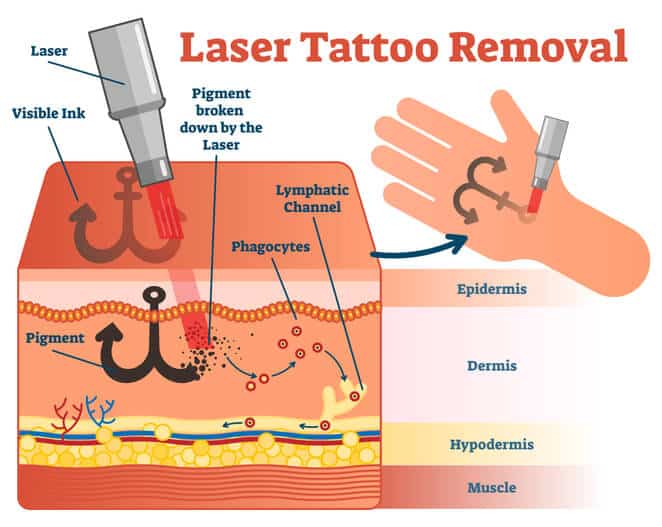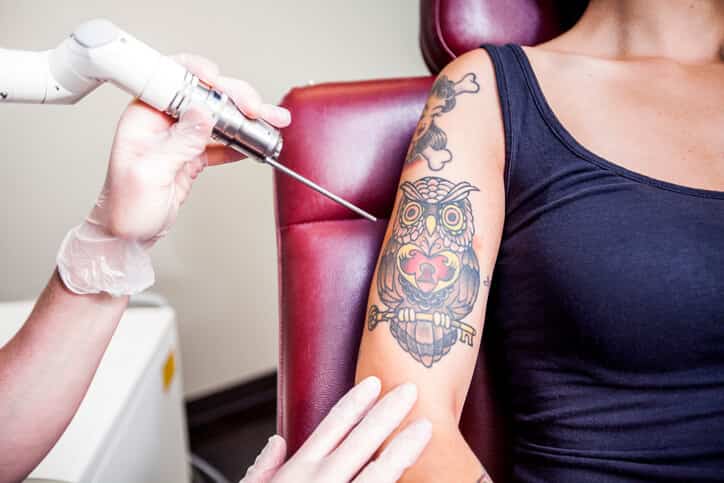Get details on how laser tattoo removal works
There are a wide variety of factors that make laser tattoo removal the safest, most effective method to remove that unwanted ink. Here’s everything you need to know about the tattoo removal process.
Still have questions? Contact us for a free consultation.
 Why are tattoos permanent?
Why are tattoos permanent?
The tattoo process deposits ink in the dermis, which is the inner layer of skin. Depositing ink particles in this layer ensures that they won’t be absorbed into the subcutaneous tissue below or leached out of the skin as the epidermis regenerates naturally.
When ink is deposited into the dermis, the body’s immune system reacts to it the same way it reacts to any other foreign body—white blood cells attempt to absorb and eliminate the foreign body.
Over time, the white blood cells eat away at the smaller ink particles, but most are still too large for the white blood cells to grab onto and remove from the skin. Because the ink particles are too large for the white blood cells to absorb, the skin cells heal around the particles and the ink becomes permanent.
How do lasers remove tattoos?
Lasers work to remove tattoos by breaking up the larger ink particles into pieces small enough for white blood cells to absorb them. To break up an ink particle, you need to heat it to make it expand due to thermal expansion, but the zap has to be quick enough so that half of the particle remains cool. The opposing cool and hot forces then separate the ink particles into smaller pieces.
Once the lasers break the ink particles apart into small enough pieces, the white blood cells can absorb them for transportation to the liver and elimination.
 Laser tattoo removal machines
Laser tattoo removal machines
Tattoo removal lasers operate in a very narrow frequency and are very, very fast. This speed and heat are crucial to cracking the ink particles efficiently and uniformly.
At EradiTatt, we use a PiQo4 laser, which uses four wavelengths to break up various colors and compositions of ink particles used in various tattoos. These additional wavelengths help to increase the colors of ink that can be removed successfully.
What tattoos can be removed?
Modern tattoo removal lasers are effective at removing most tattoos, but not all tattoos can be removed completely. Factors such as color, location, the density of the ink, and age can impact the overall success of the tattoo removal process.
Older tattoos are typically the best candidates for removal, as the ink particles weaken over time and are easier to break down. Black ink is typically easiest to remove, as it absorbs light more than other colors.
Skin type is also a factor when performing laser tattoo removal. Since darker skin types have more melanin, certain colors of ink are not able to be targeted. Black ink is safe to treat on all skin types; however extra precaution should be taken with those with more pigment in their skin to avoid possible damage to the skin.
At EradiTatt, we consider all of these factors when developing your individual treatment plan. We have great success rates of complete removal on a variety of skin tones, ages, and tattoo locations. View our tattoo removal gallery to see the results other patients have experienced.
What to expect in your laser tattoo removal session
Before your initial session, you’ll have a consultation to determine if your tattoo is a good candidate for removal we will discuss realistic expectations and possible results. The approximate treatment time, the spacing between sessions, post care of the treated area, and you will be given a text number for a rapid response for any questions or concerns throughout the process. This number can be used at night, weekends, or even holidays.
When you come in for your first session, often the same day as your initial consultation, we will once again quickly cover everything that was discussed in the consultation. Most treatments take only seconds. The treated area will have Aquaphor applied and covered with a bandage.
Does laser tattoo removal hurt?
Having a tattoo removed can be quite painful, often more so than getting a tattoo in the first place. The lasers heat the ink particles to thousands of degrees to break them down, but it happens so rapidly and in a concentrated area that the energy instead collapses into a shockwave.
This shockwave vibrates through the skin and causes the upper layer of skin to lift up and appear white, or to “frost.” Though temporarily painful, this effect usually lasts just a few seconds.
There are ways to manage the pain of laser tattoo removal. At EradiTatt, we do not offer local anesthesia or topical numbing creams (which most find to be ineffective when treating tattoos). We instead opt for a cool air system, the Cryo 6 Cool Air Device. This system helps to minimize pain with a stream of 30°C cold air. Cooling air also helps minimize thermal damage and work toward a smooth healing process.
As the tattoo site heals, you might experience some swelling, tenderness, and minor pain, similar to a sunburn. Proper laser tattoo removal aftercare can reduce discomfort.
 Laser tattoo removal aftercare
Laser tattoo removal aftercare
When you got your tattoo, your artist gave you a specific set of instructions to ensure that your tattoo healed properly and looked great. Laser tattoo removal has a similar reliance on great aftercare to ensure proper healing and optimal results.
After your session, be sure to keep the site clean, moisturized, and covered with a sterile dressing.
Alternative tattoo removal methods
There are a variety of “natural” tattoo removal methods that claim to be better alternatives to laser tattoo removal. These each come with their own quirks and risks:
- Saline tattoo removal: involves injecting a saline solution into the dermis to dilute the ink and encourage it to fall out. This method brinks ink up into the epidermis so it can slough off. This method is rarely effective and while each session is cheaper, it often takes more sessions than laser. In order to bring the ink to the surface to hopefully slough off or ooze out to the skin, a wound is created. After creating the same wound in the same area repeatedly, this is tremendous risk of pigmentation damage and scarring.
- Dermabrasion: this procedure is essentially exfoliation taken to its extreme, through chemical peels or a physical buffer. This method carries a high risk of scarring, infection, and skin irregularities.
- Tattoo removal creams: these at-home creams are meant to lighten ink gradually through topical application. Many try to hide the fact that these creams are actually bleach-based, which can lead to skin discoloration, scarring, and chemical damage to the skin.
- Excision: sometimes used for smaller tattoos, excision is actually removing the section of skin where the tattoo is located. Excision involves stitches and almost certain scarring.
Alternative tattoo removal methods
If you need a tattoo removed for a new job or military service, keep in mind that laser tattoo removal is a process that takes time. It takes multiple sessions to completely eliminate ink, and may take several sessions before tattoos show noticeable difference depending on the density and location of the ink.
We recommend a minimum of 4 to 8 weeks between sessions to allow your body time to remove the broken ink particles from your session. Contrary to popular belief, the size of the tattoos has little to nothing to do with the tattoo removal process. Even the smallest tattoos can take a long time to remove depending on the depth and density of the ink.
Choosing a laser tattoo removal specialist
Experience, technology, staff, honesty, and individual care are the most important aspects of any tattoo removal procedure. Ensuring your comfort and the best possible results should be a top priority of anyone you trust to conduct your laser tattoo removal procedure. Make sure that your chosen facility has staff that can answer all of your questions and make individual recommendations for your specific tattoo.
At EradiTatt, we believe that your laser tattoo removal specialist should be just that: completely specialized. Going to a medspa or skin treatment facility might be appealing, but often laser tattoo removal is not their specialty, and you won’t get the best possible results.
Ready to get started? Find our nearest tattoo removal location today!

 Why are tattoos permanent?
Why are tattoos permanent? Laser tattoo removal machines
Laser tattoo removal machines Laser tattoo removal aftercare
Laser tattoo removal aftercare